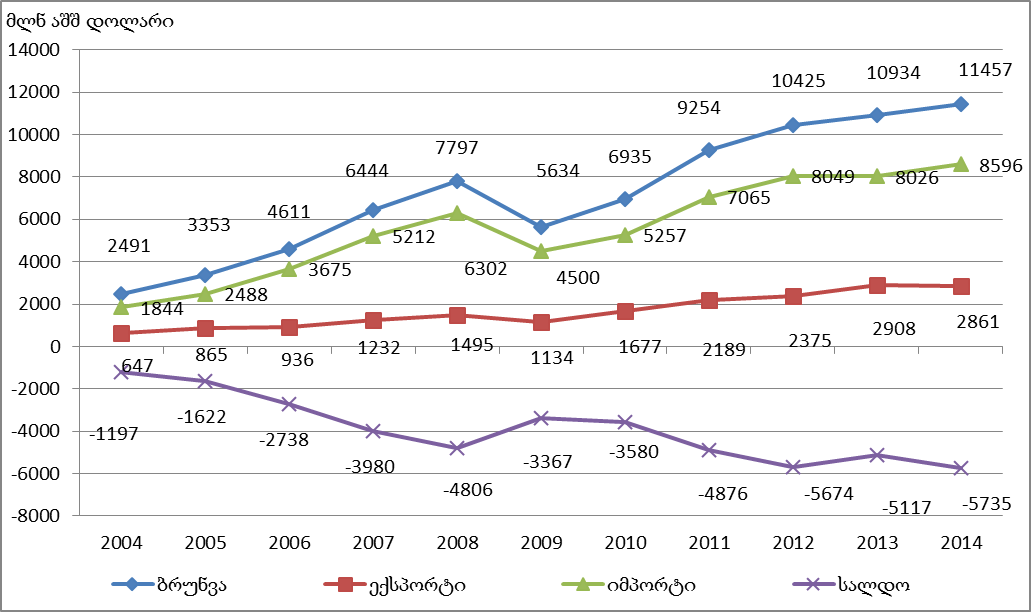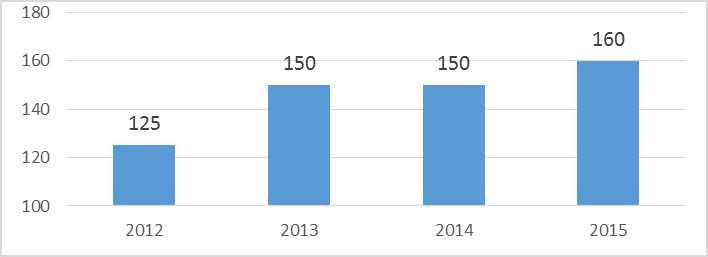On 17 March 2015, the Parliamentary Minority MP, Zurab Japaridze, stated that due to the depreciation of GEL tens of thousands of teachers and pensioners have less wages and pensions in USD than they had in 2012.
FactCheck looked into the accuracy of Zurab Japaridze’s statement.
On 31 January 2012 the exchange rate of GEL with regard to USD was 1.66 whilst on 31 March 2015 the value of USD 1 was GEL 2.23. Overall, the national currency depreciated by 25%.
Chart 1: Exchange Rate of GEL with Regard to USD (2012-2015)
 Source: National Bank of Georgia
As for the pensions, they amounted to GEL 125 in 2012 whilst they had increased to GEL 150 by January 2015. The amount of pensions will increase by GEL 10 to GEL 160 in September 2015.
Chart 2: Amount of Pensions from 2012 to 2015
Source: National Bank of Georgia
As for the pensions, they amounted to GEL 125 in 2012 whilst they had increased to GEL 150 by January 2015. The amount of pensions will increase by GEL 10 to GEL 160 in September 2015.
Chart 2: Amount of Pensions from 2012 to 2015
 On 31 January 2012, the GEL 125 pension amounted to USD 74.9 whilst it amounted to USD 73 on 31 January 2015. It should be noted that GEL had depreciated even further by 31 March 2015 which caused the amount of pension in USD to decrease further to USD 67. This constituted a 10.6% decrease as compared to 2012.
As for the wages of public school teachers, FactCheck wrote about this issue earlier as well. Our article examined the details of the amount of wages of public school teachers and the rules and procedures of distributing bonuses. The basic wage for a public school teacher amounted to GEL 245 in 2012 which was equal to USD 146.8. Today, the basic wage of a public school teacher is GEL 305 which, as of 31 March 2015, amounted to USD 136.8.
It should be noted, however, that in the given context Zurab Japaridze is not right to present the data in USD as the teachers and pensioners both receive and spend their wages in GEL. When focusing upon the growth or the decrease of wages and pensions, it is important to take into account the level of inflation. The depreciation of GEL caused inflation to increase. The annual inflation amounted to 2.6% in March 2015. This included a 6% increase in the prices of medications, 3.7% in the prices of groceries and non-alcoholic beverages and 6% in the prices of household items. However, the prices of clothing and transport decreased – by 5.3% and 6.6%, respectively. Despite this fact, it should also be pointed out that hundreds of thousands of Georgian citizens have their bank loans in USD. Hence, teachers and pensioners who have their bank loans in USD saw their income decreased.
Conclusion
The exchange rate of GEL with regard to USD was 1.66 on 31 January 2015 whilst it had increased to 2.06 in by the same month of 2015. In March 2015 (when the MP made the statement), GEL depreciated even further with regard to USD and the exchange rate amounted to 2.23. As of 1 May 2015, the exchange rate of GEL with regard to USD is 2.33.
The state pension equalled GEL 125 in 2012 which was USD 74.9 whilst the amount of pension in USD had decreased to USD 67 by 31 March 2015. As for the basic wages of public school teachers, they amounted to GEL 245 in 2012 which was USD 146.8. The basic wages had increased to GEL 305 by 2015 whilst their value in USD went down to USD 136.8 due to the depreciation of GEL.
The context in which Zurab Japaridze names the numbers is not accurate as teachers and pensioners both receive and spend their income in GEL and the depreciation of the exchange rate has no direct influence upon their welfare. However, the depreciation of GEL accelerated the increase of the prices of products (inflation) which reduces real wages and pensions. Inflation amounted to 2.6% in March 2015. In addition, according to the data of the National Bank of Georgia, 65% of bank loans in Georgia are denominated in USD and for many citizens of Georgia, including teachers and pensioners, servicing the loans becomes more expensive as the national currency depreciates.
FactCheck concludes that Zurab Japaridze’s statement is MOSTLY TRUE.
On 31 January 2012, the GEL 125 pension amounted to USD 74.9 whilst it amounted to USD 73 on 31 January 2015. It should be noted that GEL had depreciated even further by 31 March 2015 which caused the amount of pension in USD to decrease further to USD 67. This constituted a 10.6% decrease as compared to 2012.
As for the wages of public school teachers, FactCheck wrote about this issue earlier as well. Our article examined the details of the amount of wages of public school teachers and the rules and procedures of distributing bonuses. The basic wage for a public school teacher amounted to GEL 245 in 2012 which was equal to USD 146.8. Today, the basic wage of a public school teacher is GEL 305 which, as of 31 March 2015, amounted to USD 136.8.
It should be noted, however, that in the given context Zurab Japaridze is not right to present the data in USD as the teachers and pensioners both receive and spend their wages in GEL. When focusing upon the growth or the decrease of wages and pensions, it is important to take into account the level of inflation. The depreciation of GEL caused inflation to increase. The annual inflation amounted to 2.6% in March 2015. This included a 6% increase in the prices of medications, 3.7% in the prices of groceries and non-alcoholic beverages and 6% in the prices of household items. However, the prices of clothing and transport decreased – by 5.3% and 6.6%, respectively. Despite this fact, it should also be pointed out that hundreds of thousands of Georgian citizens have their bank loans in USD. Hence, teachers and pensioners who have their bank loans in USD saw their income decreased.
Conclusion
The exchange rate of GEL with regard to USD was 1.66 on 31 January 2015 whilst it had increased to 2.06 in by the same month of 2015. In March 2015 (when the MP made the statement), GEL depreciated even further with regard to USD and the exchange rate amounted to 2.23. As of 1 May 2015, the exchange rate of GEL with regard to USD is 2.33.
The state pension equalled GEL 125 in 2012 which was USD 74.9 whilst the amount of pension in USD had decreased to USD 67 by 31 March 2015. As for the basic wages of public school teachers, they amounted to GEL 245 in 2012 which was USD 146.8. The basic wages had increased to GEL 305 by 2015 whilst their value in USD went down to USD 136.8 due to the depreciation of GEL.
The context in which Zurab Japaridze names the numbers is not accurate as teachers and pensioners both receive and spend their income in GEL and the depreciation of the exchange rate has no direct influence upon their welfare. However, the depreciation of GEL accelerated the increase of the prices of products (inflation) which reduces real wages and pensions. Inflation amounted to 2.6% in March 2015. In addition, according to the data of the National Bank of Georgia, 65% of bank loans in Georgia are denominated in USD and for many citizens of Georgia, including teachers and pensioners, servicing the loans becomes more expensive as the national currency depreciates.
FactCheck concludes that Zurab Japaridze’s statement is MOSTLY TRUE.
 Source: National Bank of Georgia
As for the pensions, they amounted to GEL 125 in 2012 whilst they had increased to GEL 150 by January 2015. The amount of pensions will increase by GEL 10 to GEL 160 in September 2015.
Chart 2: Amount of Pensions from 2012 to 2015
Source: National Bank of Georgia
As for the pensions, they amounted to GEL 125 in 2012 whilst they had increased to GEL 150 by January 2015. The amount of pensions will increase by GEL 10 to GEL 160 in September 2015.
Chart 2: Amount of Pensions from 2012 to 2015
 On 31 January 2012, the GEL 125 pension amounted to USD 74.9 whilst it amounted to USD 73 on 31 January 2015. It should be noted that GEL had depreciated even further by 31 March 2015 which caused the amount of pension in USD to decrease further to USD 67. This constituted a 10.6% decrease as compared to 2012.
As for the wages of public school teachers, FactCheck wrote about this issue earlier as well. Our article examined the details of the amount of wages of public school teachers and the rules and procedures of distributing bonuses. The basic wage for a public school teacher amounted to GEL 245 in 2012 which was equal to USD 146.8. Today, the basic wage of a public school teacher is GEL 305 which, as of 31 March 2015, amounted to USD 136.8.
It should be noted, however, that in the given context Zurab Japaridze is not right to present the data in USD as the teachers and pensioners both receive and spend their wages in GEL. When focusing upon the growth or the decrease of wages and pensions, it is important to take into account the level of inflation. The depreciation of GEL caused inflation to increase. The annual inflation amounted to 2.6% in March 2015. This included a 6% increase in the prices of medications, 3.7% in the prices of groceries and non-alcoholic beverages and 6% in the prices of household items. However, the prices of clothing and transport decreased – by 5.3% and 6.6%, respectively. Despite this fact, it should also be pointed out that hundreds of thousands of Georgian citizens have their bank loans in USD. Hence, teachers and pensioners who have their bank loans in USD saw their income decreased.
Conclusion
The exchange rate of GEL with regard to USD was 1.66 on 31 January 2015 whilst it had increased to 2.06 in by the same month of 2015. In March 2015 (when the MP made the statement), GEL depreciated even further with regard to USD and the exchange rate amounted to 2.23. As of 1 May 2015, the exchange rate of GEL with regard to USD is 2.33.
The state pension equalled GEL 125 in 2012 which was USD 74.9 whilst the amount of pension in USD had decreased to USD 67 by 31 March 2015. As for the basic wages of public school teachers, they amounted to GEL 245 in 2012 which was USD 146.8. The basic wages had increased to GEL 305 by 2015 whilst their value in USD went down to USD 136.8 due to the depreciation of GEL.
The context in which Zurab Japaridze names the numbers is not accurate as teachers and pensioners both receive and spend their income in GEL and the depreciation of the exchange rate has no direct influence upon their welfare. However, the depreciation of GEL accelerated the increase of the prices of products (inflation) which reduces real wages and pensions. Inflation amounted to 2.6% in March 2015. In addition, according to the data of the National Bank of Georgia, 65% of bank loans in Georgia are denominated in USD and for many citizens of Georgia, including teachers and pensioners, servicing the loans becomes more expensive as the national currency depreciates.
FactCheck concludes that Zurab Japaridze’s statement is MOSTLY TRUE.
On 31 January 2012, the GEL 125 pension amounted to USD 74.9 whilst it amounted to USD 73 on 31 January 2015. It should be noted that GEL had depreciated even further by 31 March 2015 which caused the amount of pension in USD to decrease further to USD 67. This constituted a 10.6% decrease as compared to 2012.
As for the wages of public school teachers, FactCheck wrote about this issue earlier as well. Our article examined the details of the amount of wages of public school teachers and the rules and procedures of distributing bonuses. The basic wage for a public school teacher amounted to GEL 245 in 2012 which was equal to USD 146.8. Today, the basic wage of a public school teacher is GEL 305 which, as of 31 March 2015, amounted to USD 136.8.
It should be noted, however, that in the given context Zurab Japaridze is not right to present the data in USD as the teachers and pensioners both receive and spend their wages in GEL. When focusing upon the growth or the decrease of wages and pensions, it is important to take into account the level of inflation. The depreciation of GEL caused inflation to increase. The annual inflation amounted to 2.6% in March 2015. This included a 6% increase in the prices of medications, 3.7% in the prices of groceries and non-alcoholic beverages and 6% in the prices of household items. However, the prices of clothing and transport decreased – by 5.3% and 6.6%, respectively. Despite this fact, it should also be pointed out that hundreds of thousands of Georgian citizens have their bank loans in USD. Hence, teachers and pensioners who have their bank loans in USD saw their income decreased.
Conclusion
The exchange rate of GEL with regard to USD was 1.66 on 31 January 2015 whilst it had increased to 2.06 in by the same month of 2015. In March 2015 (when the MP made the statement), GEL depreciated even further with regard to USD and the exchange rate amounted to 2.23. As of 1 May 2015, the exchange rate of GEL with regard to USD is 2.33.
The state pension equalled GEL 125 in 2012 which was USD 74.9 whilst the amount of pension in USD had decreased to USD 67 by 31 March 2015. As for the basic wages of public school teachers, they amounted to GEL 245 in 2012 which was USD 146.8. The basic wages had increased to GEL 305 by 2015 whilst their value in USD went down to USD 136.8 due to the depreciation of GEL.
The context in which Zurab Japaridze names the numbers is not accurate as teachers and pensioners both receive and spend their income in GEL and the depreciation of the exchange rate has no direct influence upon their welfare. However, the depreciation of GEL accelerated the increase of the prices of products (inflation) which reduces real wages and pensions. Inflation amounted to 2.6% in March 2015. In addition, according to the data of the National Bank of Georgia, 65% of bank loans in Georgia are denominated in USD and for many citizens of Georgia, including teachers and pensioners, servicing the loans becomes more expensive as the national currency depreciates.
FactCheck concludes that Zurab Japaridze’s statement is MOSTLY TRUE.
Tags:








